Oscar I of Sweden
| Oscar I | |||||
|---|---|---|---|---|---|
_Wahlbergson_-_Oscar_I%2C_King_of_Sweden_and_Norway_1844-1859_-_Google_Art_Project.jpg) | |||||
| King of Sweden and Norway | |||||
| Reign | 8 March 1844 – 8 July 1859 | ||||
| Coronation | 28 September 1844, Stockholm | ||||
| Predecessor | Charles XIV & III John | ||||
| Successor | Charles XV & IV | ||||
| Born |
4 July 1799 Paris, French First Republic | ||||
| Died |
8 July 1859 (aged 60) Stockholm, Sweden | ||||
| Burial |
8 August 1859 Riddarholm Church | ||||
| Spouse | |||||
| Issue |
Charles XV of Sweden Prince Gustaf, Duke of Uppland Oscar II of Sweden Princess Eugenie Prince August, Duke of Dalarna | ||||
| |||||
| House | Bernadotte | ||||
| Father | Charles XIV John of Sweden | ||||
| Mother | Désirée Clary | ||||
| Religion |
Church of Sweden prev. Roman Catholicism | ||||
Oscar I (Joseph François Oscar Bernadotte; 4 July 1799 – 8 July 1859) was King of Sweden and Norway from 8 March 1844 until his death.[1][2][3] He was the second monarch of the House of Bernadotte.
The only child of King Charles XIV & III John, Oscar inherited the thrones upon the death of his father. Throughout his reign he would pursue a liberal course in politics in contrast to Charles XIV, instituting reforms and improving ties between Sweden and Norway. In an address to him in 1857, the Riksdag declared that he had promoted the material prosperity of the kingdom more than any of his predecessors.[4]
Early life and family
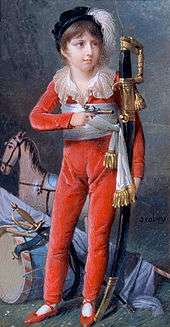
Oscar was born at 291 Rue Cisalpine in Paris (today: 32 Rue Monceau) to Jean-Baptiste Jules Bernadotte, then-French Minister of War and Sovereign Prince of Pontecorvo, and Désirée Clary, Napoleon Bonaparte's former fiancée. He was named Joseph after his godfather Joseph Bonaparte, who was married to his mother's elder sister Julie, but was also given the names François Oscar. The latter name was chosen by Napoleon after one of the heroes in the Ossian cycle of poems. Désirée is said to have chosen Napoleon to be Oscar's godfather.[5][6]
Prince of Sweden
On 21 August 1810,[7] Oscar's father was elected heir-presumptive to the Swedish throne by the Riksdag of the Estates, as King Charles XIII was without legitimate heirs. Two months later, on 5 November,[7] he was formally adopted by the king under the name of "Charles John"; Oscar was then created a prince of Sweden with the style of Royal Highness, and further accorded the title of Duke of Södermanland. Oscar and his mother moved from Paris to Stockholm in June 1811; while Oscar soon acclimatized to life at the royal court, quickly acquiring the Swedish language, Désirée had difficulty adjusting and despised the cold weather. Consequently, she left Sweden in the summer of 1811, and would not return until 1823.[8]
On 17 January 1816, Oscar was elected an honorary member of the Royal Swedish Academy of Sciences, and in 1818 was appointed chancellor of Uppsala University, where he spent one semester.[9]
Oscar became Crown Prince in 1818 upon the death of his adoptive grandfather, and the accession of Charles John to the Swedish and Norwegian thrones.
In 1832-34 he completed the romantic opera Ryno, the errant knight, which had been left unfinished on the death of the young composer Eduard Brendler. In 1839 he wrote a series of articles on popular education, and in 1841 anonymously published Om Straff och straffanstalter, a work advocating prison reforms.
Marriage and issue
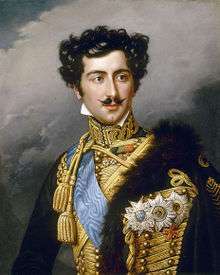
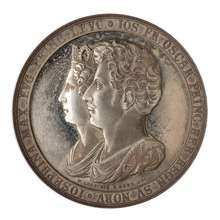
Seeking to legitimise the new Bernadotte dynasty, Charles XIV John had selected four princesses as candidates for marriage, in order of his priority:[10]
- Vilhelmina of Denmark (born 18 January 1808), daughter of Frederick VI of Denmark and Marie Sophie of Hesse-Kassel (ultimately she married first Frederick VII of Denmark and second Karl, Duke of Schleswig-Holstein-Sonderburg-Glücksburg)
- Josephine of Leuchtenberg (born 14 March 1807), daughter of Eugene, 1st Duke of Leuchtenberg and Augusta of Bavaria, and granddaughter of the Empress Josephine.[11][12]
- Marie of Hesse-Kassel (born 6 September 1804), daughter of William II, Elector of Hesse and Augusta of Prussia (ultimately she married Bernard II of Saxe-Meiningen)
- Marie of Saxe-Weimar-Eisenach (born 3 February 1808), daughter of Charles Frederick I of Saxe-Weimar and Maria Pavlovna of Russia (ultimately she married Prince Charles of Prussia)
Oscar would eventually marry Josephine, first by proxy at the Leuchtenberg Palace in Munich on 22 May 1823 and in person at a wedding ceremony conducted in Stockholm on 19 June 1823.
The couple had five children:
- King Charles XV & IV (1826–1872)
- Prince Gustaf, Duke of Uppland (1827–1852)
- King Oscar II (1829–1907)[13]
- Princess Eugenie (1830–1889)
- Prince August, Duke of Dalarna (1831–1873)
Oscar also had two illegitimate sons (unofficially called the Princes of Lapland) by his first mistress, the actress Emilie Högquist:[14]
- Hjalmar Högquist, born 18 June 1839 in Hamburg, died 1874 in London.
- Max Högquist, born 12 August 1840 in Stockholm, died 1872 in China.
With his second mistress, Jaquette Löwenhielm (née Gyldenstolpe), Oscar had a daughter:
- Oscara Hilder née Meijergeer (1819–1880)
Politics
.jpg)
In 1824 and 1833, Oscar briefly served as Viceroy of Norway.
In 1838 Charles XIV John began to suspect that his son was plotting with the Liberal politicians to bring about a change of ministry, or even his own abdication. If Oscar did not actively assist the Opposition on this occasion, his disapprobation of his father's despotic behaviour was notorious, though he avoided an actual rupture. Yet his liberalism was of the most cautious and moderate character, as the Opposition—shortly after his accession to the thrones in 1844—discovered to their great chagrin. The new king would not hear of any radical reform of the cumbersome and obsolete 1809 Instrument of Government, which made the king a near-autocrat. However, one of his earliest measures was to establish freedom of the press. He also passed the first law supporting gender equality in Sweden when he in 1845 declared that brothers and sisters should have equal inheritance, unless there was a will.[15] Oscar I also formally established equality between his two kingdoms by introducing new flags with the common Union badge of Norway and Sweden, as well as a new coat of arms for the union.
In foreign affairs, Oscar I was a friend of the principle of nationality; in 1848 he supported Denmark against the Kingdom of Prussia in the First War of Schleswig by placing Swedish and Norwegian troops in cantonments in Funen and North Schleswig (1849–1850), and was the mediator of the Truce of Malmö (26 August 1848). He was also one of the guarantors of the integrity of Denmark (the London Protocol, 8 May 1852).[12]
As early as 1850, Oscar I had conceived the plan of a dynastic union of the three Scandinavian kingdoms, but such difficulties presented themselves that the scheme had to be abandoned.[16] He succeeded, however, in reversing his father's obsequious policy towards Imperial Russia. His fear lest Russia should demand a stretch of coast along the Varanger Fjord induced him to remain neutral during the Crimean War, and, subsequently, to conclude an alliance with Great Britain and the Second French Empire (25 November 1855) for preserving the territorial integrity of Sweden-Norway.[12]
Death
In the 1850s, Oscar's health began to rapidly deteriorate, becoming paralyzed in 1857; he died two years later at the Royal Palace in Stockholm on 8 July 1859. His eldest son, who served as Regent during his absence, succeeded him as Charles XV.
Honours

.svg.png)


.svg.png)
Arms and monogram
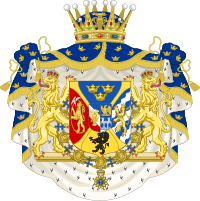 |
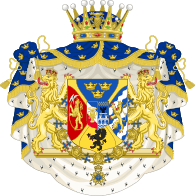 |
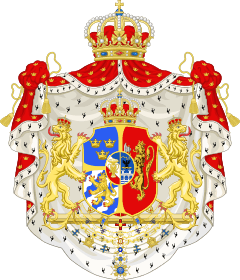 |
 |
Ancestry
| Ancestors of Oscar I of Sweden | |||||||||||||||||||||||||||||||||||||||||||||||||||||||||||||||||||||||||||||||||||||||||||||||||||||||||||||||||||||||||||||||||||||||||||||||||||||||||||||||||||||||||||||||||||||||||||||||||||||||||||||||||||||||||||||||||||||||||||||||||||||||||||||||||||||||||||||||||||||||||
|---|---|---|---|---|---|---|---|---|---|---|---|---|---|---|---|---|---|---|---|---|---|---|---|---|---|---|---|---|---|---|---|---|---|---|---|---|---|---|---|---|---|---|---|---|---|---|---|---|---|---|---|---|---|---|---|---|---|---|---|---|---|---|---|---|---|---|---|---|---|---|---|---|---|---|---|---|---|---|---|---|---|---|---|---|---|---|---|---|---|---|---|---|---|---|---|---|---|---|---|---|---|---|---|---|---|---|---|---|---|---|---|---|---|---|---|---|---|---|---|---|---|---|---|---|---|---|---|---|---|---|---|---|---|---|---|---|---|---|---|---|---|---|---|---|---|---|---|---|---|---|---|---|---|---|---|---|---|---|---|---|---|---|---|---|---|---|---|---|---|---|---|---|---|---|---|---|---|---|---|---|---|---|---|---|---|---|---|---|---|---|---|---|---|---|---|---|---|---|---|---|---|---|---|---|---|---|---|---|---|---|---|---|---|---|---|---|---|---|---|---|---|---|---|---|---|---|---|---|---|---|---|---|---|---|---|---|---|---|---|---|---|---|---|---|---|---|---|---|---|---|---|---|---|---|---|---|---|---|---|---|---|---|---|---|---|---|---|---|---|---|---|---|---|---|---|---|---|---|---|---|---|
| |||||||||||||||||||||||||||||||||||||||||||||||||||||||||||||||||||||||||||||||||||||||||||||||||||||||||||||||||||||||||||||||||||||||||||||||||||||||||||||||||||||||||||||||||||||||||||||||||||||||||||||||||||||||||||||||||||||||||||||||||||||||||||||||||||||||||||||||||||||||||
References
- ↑ "Oscar 1, Konge". Norsk biografisk leksikon. Retrieved September 1, 2016.
- ↑ "Kong Oscar I (1799-1859)". kongehuset.no. Retrieved September 1, 2016.
- ↑ "Oskar, konungar af Sverige och Norge". Nordisk familjebok. Retrieved September 1, 2016.
- ↑ Cronholm, Neander N. (1902). A History of Sweden from the Earliest Times to the Present Day. ch 40 pp 273-88
- ↑ "Karl 3 Johan, Konge". Norsk biografisk leksikon. Retrieved September 1, 2016.
- ↑ "Desideria, Dronning". Norsk biografisk leksikon. Retrieved September 1, 2016.
- 1 2 Bain 1911, p. 932.
- ↑ Lars Elgklou (1995). Familjen Bernadotte. En släktkrönika. (The Bernadotte family. A family chronicle.) (in Swedish). Skogs Boktryckeri Trelleborg. p. 21. ISBN 91-7054-755-6.
- ↑ "Karl 2". Store norske leksikon. Retrieved September 1, 2016.
- ↑ Hjalmar Lagerqvist, Sveriges drottningar
- ↑ "Josefine, Dronning". Norsk biografisk leksikon. Retrieved September 1, 2016.
- 1 2 3 Chisholm 1911.
- ↑ "Oscar 2, Konge". Norsk biografisk leksikon. Retrieved September 1, 2016.
- ↑ Söderhjelm & Palmstierna in Oscar I, Bonniers, Stockholm 1944, p. 279
- ↑ "Oscar I". Soylent Communications. Retrieved September 1, 2016.
- ↑ Lars O. Lagerqvist in Sverige och dess regenter under 1000 år (Sweden and Her Rulers for 1000 years) ISBN 91-0-075007-7 pp. 273-274
- ↑ "A Szent István Rend tagjai" Archived 22 December 2010 at the Wayback Machine.
- ↑ Le livre d'or de l'ordre de Léopold et de la croix de fer, Volume 1 /Ferdinand Veldekens
- ↑ Johann Heinrich Friedrich Berlien (1846). Der Elephanten-Orden und seine Ritter: eine historische Abhandlung über die ersten Spuren dieses Ordens und dessen fernere Entwicklung bis zu seiner gegenwärtigen Gestalt, und nächstdem ein Material zur Personalhistorie, nach den Quellen des Königlichen Geheimen-Staatsarchivs und des Königlichen Ordenskapitelsarchivs zu Kopenhagen. Gedruckt in der Berlingschen Officin. p. 168.
- ↑ "The Order of St. Olav". www.royalcourt.no. Retrieved 31 March 2018.
- ↑ "Toison Espagnole (Spanish Fleece) - 19th century" (in French), Chevaliers de la Toison D'or. Retrieved 2018-08-09.
Citations


Related reading
- Cronholm, Neander N. (1902). A History of Sweden from the Earliest Times to the Present Day. pp. 273–88.
- Ulvros, Eva Helen (2007) Oscar I: en biografi (Stockholm: Historiska media) ISBN 978-91-85507-10-8
Oscar I Born: 4 July 1799 Died: 8 July 1859 | ||
| Regnal titles | ||
|---|---|---|
| Preceded by Charles XIV/III John |
King of Sweden and Norway 1844–1859 |
Succeeded by Charles XV/IV |
| Swedish royalty | ||
| Preceded by Charles XIII/II |
Duke of Södermanland | Succeeded by Charles Oscar |
| Italian nobility | ||
| Preceded by Josephine |
Duke of Galliera with Josephine 1823–1837 |
Succeeded by Raffaele de Ferrari |